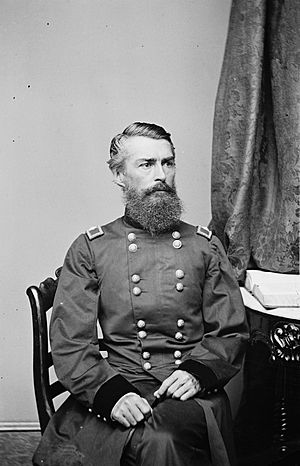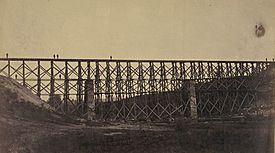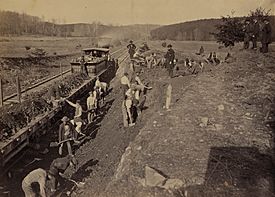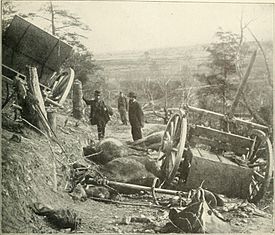Herman Haupt facts for kids
Quick facts for kids
Herman Haupt
|
|
|---|---|

Gen. Herman Haupt
|
|
| Born | March 26, 1817 Philadelphia, Pennsylvania |
| Died | December 14, 1905 (aged 88) Jersey City, New Jersey |
| Place of burial |
West Laurel Hill Cemetery
Bala Cynwyd, Pennsylvania |
| Allegiance | United States |
| Service/ |
United States Army |
| Years of service | 1835; 1862–1863 |
| Rank | |
| Commands held | U.S. Military Railroads |
| Battles/wars | American Civil War |
| Signature | |
Herman Haupt (March 26, 1817 – December 14, 1905) was an amazing American civil engineer and railroad builder. He was also a leader in the railroad business. During the American Civil War, he became a Union Army General. He completely changed how the U.S. military used railroads to move soldiers and supplies.
Contents
Early Life and Family
Herman Haupt was born in Philadelphia, Pennsylvania, on March 26, 1817. His father, Jacob, was a merchant who sadly passed away when Herman was only 12 years old. This left his mother, Anna, to care for their five children.
Herman worked part-time to help pay for his school. In 1831, when he was 14, President Andrew Jackson appointed him to the United States Military Academy at West Point. He graduated in 1835 and became a second lieutenant. In 1838, he married Ann Cecelia Keller. They had a large family with seven sons and four daughters.
Building a Career in Engineering
After graduating from West Point, Haupt left the Army to work as an engineer. He helped survey land for new railroads, like the Norristown and Allentown Railroad. At just 19, he surveyed a line from Gettysburg to the Potomac River. This route later became part of the Western Maryland Railroad.
In 1839, Haupt invented a special way to build bridges called the Haupt Truss. Two of his truss bridges, built in 1854, can still be seen today in Altoona, Pennsylvania and Ardmore, Pennsylvania.
Haupt also taught mathematics and engineering at Gettysburg College. He caught the attention of J. Edgar Thomson, who was the chief engineer for the Pennsylvania Railroad. Haupt joined the Pennsylvania Railroad in 1847. He later became its general superintendent. Haupt and Thomson designed the famous Horseshoe Curve. This amazing railway curve helped the Pennsylvania Railroad cross the Allegheny Mountains and reach Pittsburgh, Pennsylvania.
From 1851 to 1856, Haupt continued to work as a chief engineer. He completed the Mountain Division of the Pennsylvania Railroad, including the Allegheny Tunnel. He also worked on the five-mile-long Hoosac Tunnel in Massachusetts.
Civil War Contributions
In 1862, during the Civil War, the U.S. War Department created a new group. This group was in charge of building and running military railroads. On April 27, Haupt was chosen to lead this group. He was made a Colonel and an aide to Major general Irvin McDowell.
Haupt quickly got to work repairing damaged railroad lines near Washington, D.C. He also trained railroad workers and improved telegraph communication. One of his toughest jobs was fixing the important Richmond, Fredericksburg and Potomac Railroad line. This included the Potomac Creek Bridge, which Confederate forces had partly destroyed.
Even with new workers and many challenges, Haupt had the line working again in less than two weeks! President Abraham Lincoln was very impressed. He visited the bridge and said, "That man Haupt has built a bridge four hundred feet long and one hundred feet high, across Potomac Creek, on which loaded trains are passing every hour, and upon my word, gentlemen, there is nothing in it but cornstalks and beanpoles."

Haupt was promoted to brigadier general in September 1862. He preferred to serve without official rank or pay, as he wanted the freedom to work in private business. He also preferred civilian crews, including former slaves, over military ones. His Construction Corps grew to include bridge-builders and workers who built freight cars and warehouses.
Haupt also experimented with new ways to destroy bridges using "torpedoes" (which were like early mines). He also tested a lightweight tool to twist railroad tracks. This tool was used in raids behind enemy lines.
Haupt left the Army in September 1863. But in his year as a general, he made a huge difference. The Civil War was one of the first wars to use railroads to move armies and supplies quickly. Haupt helped the Union Army of Virginia and Army of the Potomac. He was especially helpful during the Gettysburg Campaign, an area he knew well. His quickly organized trains kept the Union Army well supplied. He also used returning trains to carry thousands of wounded Union soldiers to hospitals.
After the Battle of Gettysburg, Haupt was the first to tell President Lincoln that General Robert E. Lee's defeated Confederate army was not being chased quickly enough.
Haupt developed important rules for how military railroads should work. His main ideas were that the military should not interfere with the railroad's efficiency. Also, trains should be emptied and returned quickly so they could be used again.
Later Life and Legacy
After the war, Haupt went back to building railroads, bridges, and tunnels. He worked for several railroad companies, including the Northern Pacific Railroad. He also became president of the Dakota and Great Southern Railroad.
Haupt became wealthy from his investments. However, he later lost much of his money. He and his wife bought a small hotel in Virginia. He also invented a drilling machine that won an award in Great Britain. He was also the first to show that oil could be transported through pipes.
Haupt wrote several books about engineering, including Hints on Bridge Building (1840) and Military Bridges (1864). He also wrote his Reminiscences (1901).
Herman Haupt passed away from a heart attack at age 88 in Jersey City, New Jersey. He was traveling on a train at the time. He is buried in West Laurel Hill Cemetery in Bala Cynwyd, Pennsylvania. His son, Lewis M. Haupt, also became a famous civil engineer.
Selected Works
- Hints on Bridge Building, published in 1840
- General Theory of Bridge Construction, 1851
- Plan for Improvement of the Ohio River, 1855
- Military Bridges, 1864
- Report upon the System of the Holly Steam Combination Co. Ltd., 1879
- Reminiscences of General Herman Haupt Wright & Joys, 1901
See also
- List of American Civil War generals (Union)
- United States Military Railroad



